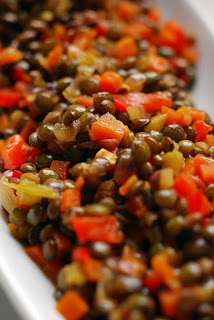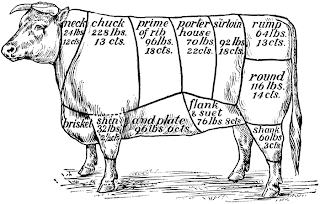In winter there is but one glorious, soulful way to cook that surpasses the rest . And if you know me, I'm talking even more than roasting. I sing now- the praise of the braise.
For, it's the hearty effects of that slow, steady process of simmering chunks of meat in a heady stock with tannic red wine and root vegetables that can make the most rugged mountaineer swoon in his boots. If a spicy bowl of chili nips at the heels of your taste buds as it goes down, a braise of tender short ribs or veal osso bucco kisses and numbs your palette, convincing you to slow the pace of your bites, savoring every last decadent forkful of flavor.
Braised meats were historically the cuts of meat that came from the part of the animal that got a lot of exercise, or contained a level of fat or tissue that was necessary to render in order to get to the prized meat within. Cooks were not in a position to waste any part of the animal at a time when there was no refrigeration, and so, necessity brought us the classical techniques of salt-curing, smoking, confit and canning to preserve what could not be used fresh. And what wasn't cooked right away over an open fire required another method of preparation that made the meat both palatable and flavorful (not to mention, chewable).
 Soups are the distant cousin of the braise, but perhaps what gives braising it's most unique distinction is the combination of methods of "dry" and "moist" heat cooking. We all know that searing meat creates flavor. And that given the choice between a grilled ribeye steak and a boiled one, we're going to go for the grill. But, what if a larger cut, like the shanks of lamb or veal are at hand? The aforementioned fat and connective tissue within these cuts of meat require the "moist" heat, as well, to bring about the signature fork-tender qualities of a proper braise. Searing the meat first, and then adding aromatic vegetables (such as root), along with earthy red wine, savory herbs and stock, now take the meat to a new level.
Soups are the distant cousin of the braise, but perhaps what gives braising it's most unique distinction is the combination of methods of "dry" and "moist" heat cooking. We all know that searing meat creates flavor. And that given the choice between a grilled ribeye steak and a boiled one, we're going to go for the grill. But, what if a larger cut, like the shanks of lamb or veal are at hand? The aforementioned fat and connective tissue within these cuts of meat require the "moist" heat, as well, to bring about the signature fork-tender qualities of a proper braise. Searing the meat first, and then adding aromatic vegetables (such as root), along with earthy red wine, savory herbs and stock, now take the meat to a new level. The whole pot is brought to a simmer and covered. It's then left on the stove or placed in the oven at a low heat to keep a steady, constant temperature. This is where the moist heat, or steam, takes over. As the vapor from the braise rises up, it is returned back into the braising pot, retaining the moisture necessary to cook, but also intensifying the marrying flavors as they meticulously reduce. Sharp garlic becomes mellow, sweet carrots release their sugars, fresh rosemary and thyme tame the unctuous, gamy nature of these lesser cuts of meat. And red wine perfumes the sauce (and the whole house) to leave you anticipating the very first velvety bite.
 Coq au Vin, Beef Bourguignon, Osso Bucco, short ribs- these are all dishes that apply the combination cooking method of braising. But, braising isn't limited to meats. Oh no, no, no. What vegetables could you apply this philosophy to that would allow flavors to both mellow and texture to soften? Artichokes and brussels sprouts come to mind, as does braising greens, like swiss chard and kale. One of my all time favorites is fennel. The other night for dinner, my wife and I had wild striped bass over braised leeks, fennel and celery with lentils, a very wintry meal for sure. Searing slightly the fennel (because of its firm texture) in butter, I then added the softer celery and leeks and reduced the heat. In place of a full on stock, I added butter and white wine, making sure the lid was in place to retain that all important steam element. Occasionally stirring and checking the texture, the fish roasted in no time, and the lentils sat covered beneath their own earthy steam, waiting for the dish to come together.
Coq au Vin, Beef Bourguignon, Osso Bucco, short ribs- these are all dishes that apply the combination cooking method of braising. But, braising isn't limited to meats. Oh no, no, no. What vegetables could you apply this philosophy to that would allow flavors to both mellow and texture to soften? Artichokes and brussels sprouts come to mind, as does braising greens, like swiss chard and kale. One of my all time favorites is fennel. The other night for dinner, my wife and I had wild striped bass over braised leeks, fennel and celery with lentils, a very wintry meal for sure. Searing slightly the fennel (because of its firm texture) in butter, I then added the softer celery and leeks and reduced the heat. In place of a full on stock, I added butter and white wine, making sure the lid was in place to retain that all important steam element. Occasionally stirring and checking the texture, the fish roasted in no time, and the lentils sat covered beneath their own earthy steam, waiting for the dish to come together. After the requisite few hours needed to complete a righteous braise, you can then decide on what to pair with the tender results. Osso bucco is very often served with risotto- of any kind. Mushrooms, cheese, herbs, root veggies are all on the "friend" list of risotto. Beef braises call for a buttery mashed potato with horseradish, say, or farmhouse cheddar, while appley, sweet pork can go with everything from soft polenta (or cheesy grits! Hell, YEAH!) to hand-made pasta, with a second tier of braising- cioppolini onions. And then- there's rabbit. In my blue heaven, there is a large, white, wide-rimmed bowl of freshly made, hand-cut papardelle pasta with rabbit braised in white wine and dry vermouth, scented with parsnips and fresh porcini mushrooms. *sigh* Okay, okay- and truffles.
After the requisite few hours needed to complete a righteous braise, you can then decide on what to pair with the tender results. Osso bucco is very often served with risotto- of any kind. Mushrooms, cheese, herbs, root veggies are all on the "friend" list of risotto. Beef braises call for a buttery mashed potato with horseradish, say, or farmhouse cheddar, while appley, sweet pork can go with everything from soft polenta (or cheesy grits! Hell, YEAH!) to hand-made pasta, with a second tier of braising- cioppolini onions. And then- there's rabbit. In my blue heaven, there is a large, white, wide-rimmed bowl of freshly made, hand-cut papardelle pasta with rabbit braised in white wine and dry vermouth, scented with parsnips and fresh porcini mushrooms. *sigh* Okay, okay- and truffles. DRINK: Man, oh, man- the choices are many. As a rule, with richer cuts of meat, go for more tannic, earthy wines such as barbera, chianti and chateauneuf du pape. The more subtle the seasonings, you can delve into the beauties and mystery of burgundy or pinot noir from the north west US. A clean, dry porter or milk stout could both season a beef braise as well as accompany it at the table. And the heavenly rabbit of my dreams would become even more sublime with a mature barolo or barbaresco. (note to self- must EAT before blogging *gulp*)


2 comments:
Now that I have wiped the drool from my mouth I can send an email thanking you for your wonderful description of braising. Instead of whining about the cold winds of winter, I can now embrace them as an excuse to enjoy those sumptuous options you described. That sound you just heard was the pop of the Pinot Noir which is now breathing while the pork is brasing.
hey chef, try braising in an emile henry brazier next time. even more flavors will emerge. see you at the restaurant. ej
Post a Comment